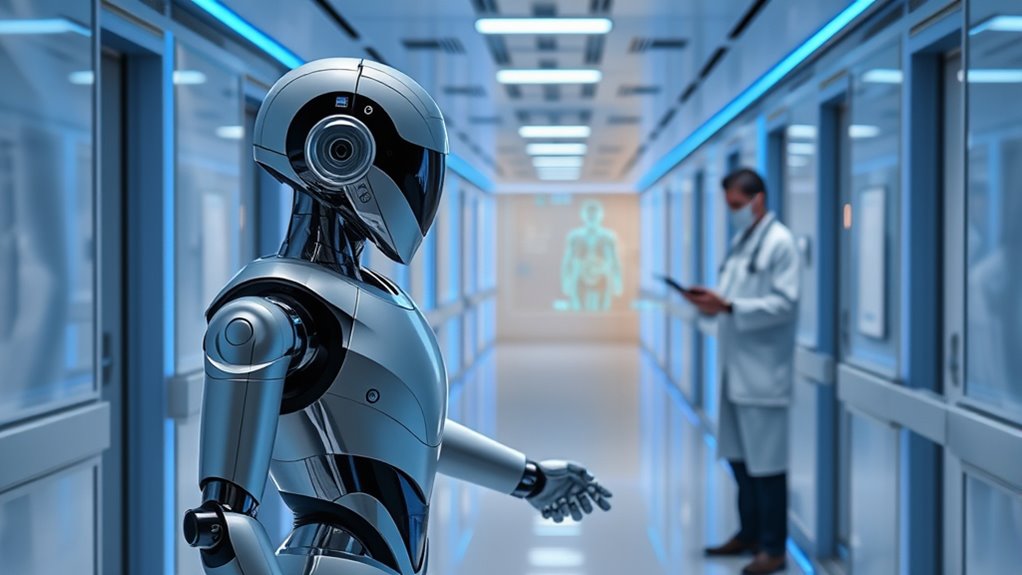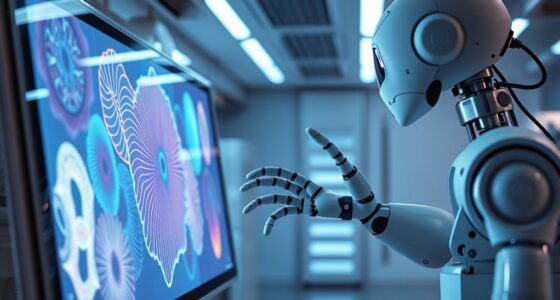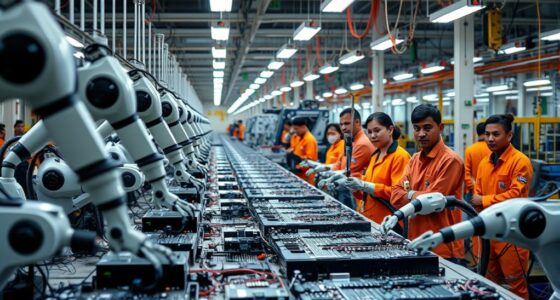As AI advances, healthcare is becoming highly automated, with machines handling diagnostics, treatment planning, and administrative tasks. You might wonder if doctors will soon act mainly as supervisors, similar to taxi drivers overseeing autonomous vehicles. While automation improves efficiency and accuracy, human touch remains essential for compassionate care and complex decisions. If you keep exploring, you’ll see how the role of doctors is evolving alongside these technological shifts, shaping the future of healthcare.
Key Takeaways
- AI automates many administrative tasks, allowing doctors to focus more on patient care rather than paperwork.
- Advanced diagnostics and personalized treatments are increasingly driven by AI, augmenting doctor decision-making.
- Some routine procedures may be fully automated, potentially reducing the need for human intervention in certain contexts.
- AI’s reliability and ethical concerns could challenge the traditional doctor-patient relationship.
- Despite automation, the human element remains crucial for complex decision-making and empathetic patient interactions.

Have you ever wondered how healthcare is becoming more automated and efficient? Today, AI is transforming hospitals and clinics into well-oiled machines, where decision-making, diagnostics, and administrative tasks increasingly rely on intelligent systems. With 80% of hospitals now integrating AI to enhance patient care and operational efficiency, it’s clear that automation is no longer optional but essential. The global AI healthcare market has exploded, reaching over $32 billion in 2024 and expected to skyrocket to more than $431 billion by 2032. This growth isn’t just numbers; it’s a sign that AI-driven tools are becoming core to how healthcare functions.
AI is revolutionizing healthcare, with 80% of hospitals adopting intelligent systems to improve care and efficiency.
One of the most striking advances is diagnostic accuracy. AI tools analyze medical images like X-rays and MRIs with up to 98% precision, enabling radiologists to make faster, more accurate diagnoses. Real-time imaging analysis reduces the time it takes to identify conditions, helping patients get treatment sooner. AI systems like IBM Watson can sift through genetic and health data to craft personalized treatment plans, improving outcomes for complex diseases such as Alzheimer’s and diabetes. These capabilities mean fewer missed diagnoses and earlier intervention, ultimately saving lives. AI diagnostic tools are also increasingly capable of detecting rare diseases that might otherwise go unnoticed. Additionally, the integration of clinical data management systems enhances the overall quality of patient care and streamlines workflows.
On the administrative side, AI is revolutionizing workflows. It saves providers about 66 minutes daily by automating documentation, freeing up time for direct patient care. Automated patient intake and triage systems streamline registration, reducing waiting times and administrative errors. Scheduling, claims processing, and insurance verification are optimized through AI-powered algorithms, making hospital operations more cost-effective. Embedding predictive models into electronic health records supports better decision-making, minimizing mistakes and reducing resource waste. These efficiencies translate into lower costs and better patient experiences.
Cost savings are substantial. AI tools could save the U.S. healthcare system up to $150 billion annually by reducing unnecessary tests and procedures—roughly 30% of some medical interventions. Hospitals employing predictive analytics report up to a 50% reduction in readmissions, proving AI’s role in proactive patient management. Faster decision-making, driven by Generative AI, is now a reality for 65% of healthcare leaders, enabling quicker responses to changing clinical needs. Automated workflows also cut operational expenses, making healthcare more sustainable.
However, challenges remain. Data privacy concerns and integrating AI with existing legacy systems complicate deployment. Some providers remain skeptical about AI’s reliability, while a shortage of skilled professionals limits broader adoption. Ethical issues like algorithmic bias in diagnostics still need addressing. Despite these hurdles, patient engagement is rising, with more consumers using AI symptom checkers and virtual assistants. Younger populations are especially open to AI-driven health tools, fostering trust and acceptance.
Looking ahead, AI’s role in healthcare will only grow. Predictive analytics markets are expanding at a 24% CAGR through 2030, and generative AI will become central to hospital operations. As AI continues to evolve, the question isn’t whether healthcare will become automated but how quickly it will replace traditional roles—possibly even turning doctors into the next taxi drivers of medicine. [The rapid pace of AI innovation is also creating new jobs and opportunities within healthcare.
Frequently Asked Questions
How Will Patient-Doctor Relationships Change With Auto-Piloted Healthcare?
You’ll notice patient-doctor relationships shift as AI becomes more involved. You might spend less time on routine tasks, freeing up more meaningful conversations. Patients could feel more empowered with accessible information, but also more confused if AI outputs clash with your advice. Trust may fluctuate, so transparent communication about AI’s role is vital. Ultimately, your role evolves into a partner guiding patients through tech-driven decisions, maintaining human connection amidst automation.
What Are the Legal Liabilities Involved in Autonomous Medical Decision-Making?
You need to understand the legal liabilities in autonomous medical decision-making. Existing tort laws may not fully cover AI harm, so liability could shift to creators or providers controlling the AI. Patients retain rights under Montgomery, demanding full disclosure of risks. Regulators face challenges creating proactive rules, while courts decide if harm stems from product issues or negligence. Insurance requirements might also hold developers accountable, ensuring proper coverage for AI-related risks.
How Secure Is Patient Data in Automated Healthcare Systems?
Think of patient data as a precious treasure chest. In automated healthcare, AI acts as a vigilant guardian, encrypting data and monitoring access in real-time. It employs advanced tools like differential privacy and role-based controls to shield sensitive info from hackers and leaks. While no system is flawless, these measures markedly strengthen security, giving you confidence that your health records stay private amidst the digital frontier.
Will Auto-Piloted Healthcare Reduce or Increase Healthcare Costs?
Auto-piloted healthcare will likely reduce costs by streamlining administrative tasks, improving diagnostic accuracy, and shortening hospital stays. You’ll see savings from AI-driven efficiencies, such as $150 billion annually in administrative costs and billions more in clinical improvements. While initial investments are high, the long-term benefits include lower treatment expenses and system-wide efficiency gains. Overall, automation’s benefits suggest it will help make healthcare more affordable for everyone.
What Training Will Doctors Need to Adapt to Autonomous Medical Technologies?
Imagine stepping into a high-tech clinic where your skills blend seamlessly with AI tools. To adapt, you’ll need interdisciplinary training that combines clinical expertise with data science. Expect to participate in multidisciplinary programs, learn AI ethics, and develop teamwork with technology. You’ll also hone traditional diagnostic skills, ensuring you remain confident without tech support in low-resource settings. This continuous learning will keep you ahead in a rapidly evolving, AI-driven healthcare landscape.
Conclusion
As healthcare automation advances, it’s easy to wonder if doctors will soon be supplanted. But remember, over 70% of patients still value personal connection and trust in their caregivers. While technology can improve efficiency and accuracy, it can’t replace the compassion and intuition only humans provide. Embracing these tools while preserving the human touch ensures you get the best care possible—because behind every diagnosis, there’s a person who truly cares.









